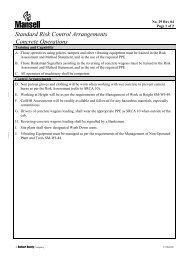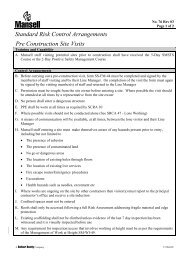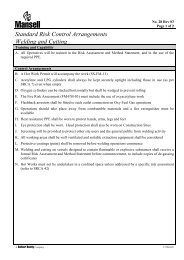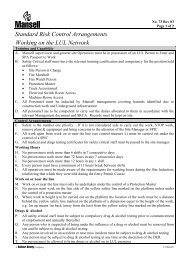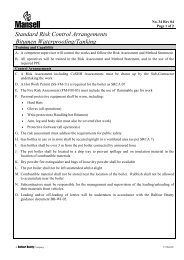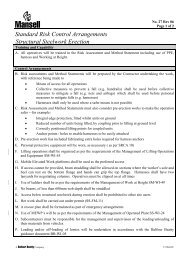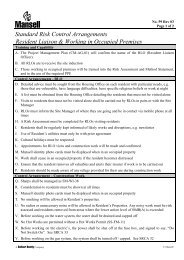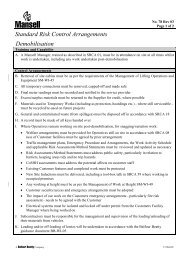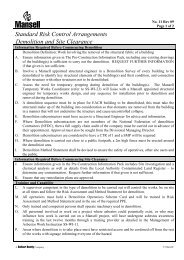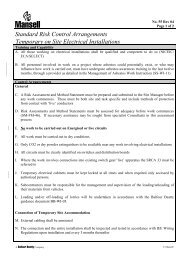Management of Lifting Operations and Equipment - to return to the ...
Management of Lifting Operations and Equipment - to return to the ...
Management of Lifting Operations and Equipment - to return to the ...
Create successful ePaper yourself
Turn your PDF publications into a flip-book with our unique Google optimized e-Paper software.
SM-WI-45-03<br />
a<br />
Page 5 <strong>of</strong> 15<br />
<strong>Management</strong> <strong>of</strong> <strong>Lifting</strong> <strong>Operations</strong> <strong>and</strong> <strong>Equipment</strong><br />
Table 1 – Lift Planning Key Considerations <strong>and</strong> Requirements<br />
Key Consideration Requirements Control Ref.<br />
Ground conditions<br />
<strong>and</strong> bearing<br />
capacity<br />
<strong>Lifting</strong> <strong>Equipment</strong><br />
Capacity (load /<br />
reach)<br />
<strong>Equipment</strong><br />
Condition, Age,<br />
Maintenance, Test /<br />
Inspection Regime<br />
Site Access<br />
(dimensions <strong>and</strong><br />
ground conditions)<br />
Lay down Areas<br />
Care <strong>of</strong> Materials<br />
<strong>Lifting</strong> Points<br />
Slinging Practice<br />
Segregation <strong>of</strong><br />
<strong>Lifting</strong> Zone<br />
Wind Speed<br />
Appointment <strong>of</strong><br />
Competent People<br />
An assessment <strong>of</strong> ground conditions, including load bearing<br />
capacities must be made through <strong>the</strong> TWC <strong>and</strong> APL for any<br />
equipment transferring load <strong>to</strong> <strong>the</strong> ground.<br />
Load spreading mats must be appropriately specified in <strong>the</strong><br />
Lift Plan.<br />
Checks must be made for underground voids <strong>and</strong> services<br />
which may collapse.<br />
The capacity <strong>of</strong> lifting equipment must be adequate for <strong>the</strong><br />
load <strong>and</strong> reach required. Therefore, <strong>the</strong> weight <strong>of</strong> each item<br />
<strong>to</strong> be lifted must be identified.<br />
Plant <strong>and</strong> equipment must be maintained with tests,<br />
thorough examinations, inspections <strong>and</strong> maintenance at<br />
intervals as specified by <strong>the</strong> manufacturer <strong>and</strong> legislation.<br />
The route on<strong>to</strong> site must be assessed <strong>to</strong> confirm that lifting<br />
plant can safely access without causing damage <strong>to</strong> roads,<br />
pavements or o<strong>the</strong>r existing features.<br />
Lay down areas must be adequately prepared (firm <strong>and</strong><br />
level) <strong>and</strong> <strong>of</strong> sufficient size e.g. it must not become<br />
necessary <strong>to</strong> walk on steel.<br />
Where materials are susceptible <strong>to</strong> damage through lifting<br />
<strong>and</strong> stacking <strong>the</strong> Lift Plan <strong>and</strong> RAMS must specify controls<br />
necessary <strong>to</strong> protect <strong>the</strong> materials e.g. pre-cast floor planks<br />
must be supported in a particular way when stacked on site<br />
<strong>to</strong> avoid cracking <strong>and</strong> subsequent failure when next lifted.<br />
<strong>Lifting</strong> points must be identified in <strong>the</strong> lifting plan <strong>and</strong><br />
where reasonably practicable designed in.<br />
<strong>Lifting</strong> points on modular or precast products must be<br />
designed <strong>and</strong> prefabricated in.<br />
Slinging arrangements must be specified in <strong>the</strong> Lift Plan in<br />
order that loads are secure <strong>and</strong> stable, <strong>and</strong> so that nei<strong>the</strong>r <strong>the</strong><br />
load nor lifting equipment is damaged. The need for lifting<br />
beams must be considered.<br />
Those not involved in <strong>the</strong> lift must be excluded from <strong>the</strong><br />
lifting zone. Alternative access routes must be detailed in<br />
<strong>the</strong> Lift Plan or RAMS where required.<br />
The maximum safe wind speed for <strong>the</strong> lifting operation<br />
must be specified in <strong>the</strong> Lift Plan <strong>and</strong> a means <strong>of</strong> measuring<br />
wind speed (anemometer) available near <strong>the</strong> point <strong>of</strong> work.<br />
The Lift Plan must confirm <strong>the</strong> required competent<br />
personnel required <strong>to</strong> execute <strong>the</strong> lift safely, in accordance<br />
with <strong>the</strong> <strong>Lifting</strong> Plan.<br />
<br />
<br />
<br />
<br />
<br />
<br />
CS = Control Section<br />
Temporary Works<br />
(SS-WI-23)<br />
Working Platform<br />
WI (SM-WI-46)<br />
Figure 1<br />
Utility Avoidance,<br />
Excavation & Road<br />
Work (SM-WI-56)<br />
Crane Lift Plan<br />
(SM-FM-41)<br />
Non-Crane Lift Plan<br />
(SS-FM-53)<br />
CS1<br />
CS2<br />
Manufacturer<br />
information.<br />
CS1<br />
CS2<br />
Manufacturer<br />
Information<br />
Schedule <strong>of</strong><br />
Common <strong>Lifting</strong><br />
Techniques<br />
(SS-WI-22)<br />
CS1<br />
A Balfour Bea~y Company Uncontrolled when downloaded or printed © Mansell



